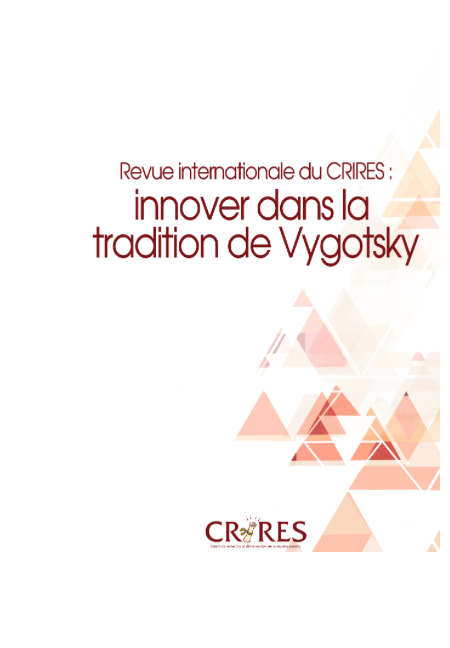Mediation in the context of learning a second language: Origins and perspectives
DOI:
https://doi.org/10.51657/ric.v5i2.51251Keywords:
mediation, cultural-historical activity theory (CHAT), activity system (SA), second language learning, language classesAbstract
This article is a review of the literature on the use of cultural-historical activity theory (CHAT) in the context of language instruction. It explores the concept of mediation as applied to the learning of a second language. First introduced by Vygotsky (1978) and expanded upon by researchers such as Engeström (2015) and Prenkert (2010), this concept is often presented by researchers in the field of second language teaching without being operationalized. Stemming from this observation, the objectives of the present article are to redefine the concept of mediation, to circumscribe its role in the activity system, and to describe its role in second language teaching research. It also aims to highlight the new applications of mediation as used in the second language classroom. To do so, a narrative literature review based on data bases (LLBA, ERIC, EBSCO, PsycNET, SOFIA) and inclusion criteria is carried out. The texts on which this literature review rests are empirical in nature and operationalize mediation in context. The analysis of the texts reveals a shared definition of mediation and a common idea as to the role of mediation in the second language classroom. In this regard, it draws parallels between the different elements of the activity system. Finally, several contributions of the selected texts are revealed: (1) the dual role of language as mediator and object, (2) the role of learning strategies as mediators, (3) the role of class culture as a mediator, and (4) the use of new artefacts in the classroom.
References
Albusaidi, S. (2019). Using Activity Theory to explain how a student learns in an internationalised classroom from a sociocultural perspective. Journal of Language Teaching and Research, 10(6), 1142-1149. http://dx.doi.org/10.17507/jltr.1006.02
Cho, H. (2017). Synchronous web-based collaborative writing: Factors mediating interaction among second-language writers. Journal of Second Language Writing, 36, 37–51. https://doi.org/10.1016/j.jslw.2017.05.013
Donato, R., & McCormick, D. (1994). A sociocultural perspective on language learning strategies: The role of mediation. Modern Language Journal, 78(4), 453–464. https://doi-org.acces.bibl.ulaval.ca/10.2307/328584
Engeström, Y. (1987). Learning by expanding: An activity-theoretical approach to developmental research (1ère ed.). Cambridge University Press. https://doi.org/10.1017/CBO9781139814744
Engeström, Y. (2015). Learning by expanding: An activity-theoretical approach to developmental research (2ième ed.). Cambridge University Press. https://doi.org/10.1017/CBO9781139814744
Fajardo, G. R., & Torres-Guzmán, M. E. (2016). "Now I see how my students feel": Expansive learning in a language awareness workshop. Language Awareness, 25(3), 222–240.https://doi.org/10.1080/09658416.2016.1179745
Ganem-Gutierrez, G. A. (2014). A sociocultural theory approach to the design and evaluation of 3D virtual world tasks. In M. Gonzalez-Lloret & L. Ortega (Eds.), Technology-mediated TBLT: Researching technology and tasks (pp. 149-182). John Benjamins. https://doi.org/10.1075/tblt.6
Ganem-Gutierrez, G. A. (2018). Collaborative activity in the digital world. In J. P. Lantolf, M. E. Poehner, & M. Swain (Eds.), The Routledge handbook of sociocultural theory and second language development (pp. 391-408). Routledge. https://www.routledge.com/The-Routledge-Handbook-of-Sociocultural-Theory-and-Second-Language-Development/Lantolf-Poehner-Swain/p/book/9781138651555
Herazo, J. D., Davin, K. J., & Sagre, A. (2019). L2 Dynamic Assessment: An Activity Theory perspective. The Modern Language Journal 103(2), 443-458. https://doi.org/10.1111/modl.12559
Igira, F. T., & Gregory, J. (2009). Cultural Historical Activity Theory. In Y. K. Dwivedi, L. Banita, M. D. Williams, S. L. Schneberger, & M. Wade (Eds.), Contemporary theoretical models in information systems (pp. 434-454). IGI Global.
Lantolf, J. P., Poehner, M. E., & Thorne, S. L. (2020). Sociocultural theory and L2 development. In B. VanPatten, G. D. Keating, & S. Wulff (Eds.), Theories in second language acquisition: An introduction (3rd ed., pp. 223-247). Routledge.
Leontʹev, A. N. (1978). Activity, consciousness, and personality. Prentice Hall. https://www.worldcat.org/title/activity-consciousness-and-personality/oclc/3770804
Liang, X. (2009). Investigating mediations in student activities in an English immersion context in mainland China. English Language Teaching, 2(4), 38-50. 10.5539/elt.v2n4p38
Lin, C., Lin, V., Liu, G., Kou, X., Kulikova, A., & Lin, W. (2020) Mobile-assisted reading development: A review from the Activity Theory perspective. Computer Assisted Language Learning, 33(8), 833-864. https://doi.org/10.1080/09588221.2019.1594919
Loewen, S. (2020). Introduction to instructed second language acquisition (2ième ed.). Routledge. https://www.routledge.com/Introduction-to-Instructed-Second-Language-Acquisition/Loewen/p/book/9781138671782
Lompscher, J. (2006). The cultural-historical development of Activity Theory: Some aspects of development. In P. Sawchuk, N. Duarte, & M. Elhammoumi (Eds.), Critical perspectives on activity: Explorations across education, work, and everyday life (pp. 35-51). Cambridge University Press. https://www.cambridge.org/ca/academic/subjects/psychology/cultural-psychology/critical-perspectives-activity-explorations-across-education-work-and-everyday-life?format=HB
Luk, J. C. M. (2013). Forms of participation and semiotic mediation in board games for second language learning. Pedagogies: An International Journal, 8(4), 352–368. http://dx.doi.org/10.1080/1554480X.2013.829279
Niu, R., Lu, K., & You, X. (2018). Oral language learning in a foreign language context: Constrained or constructed? A sociocultural perspective. System, 7(4), 38-49. https://doi.org/10.1016/j.system.2018.02.006
Prenkert, F. (2010). Tracing the roots of activity systems theory: An analysis of the concept of mediation. Theory & Psychology, 20(5), 641-665. https://doi.org/10.1177/0959354310375329
Razfar, A., Licón Khisty, L., & Chval, K. (2011). Re-mediating second language acquisition: A sociocultural perspective for language development. Mind, Culture, and Activity, 18(3), 195–215. https://doi-org.acces.bibl.ulaval.ca/10.1080/10749030903494427
Roth, W. (2007). On mediation: Toward a cultural-historical understanding. Theory & Psychology, 17(5), 655-680. https://doi.org/10.1177/0959354307081622
Sannino, A., Daniels, H., & Gutiérrez, K. D. (2009). Learning and expanding with activity theory. Cambridge University Press.
Storch, N., & Sato, M. (2020). Comparing the same task in ESL vs. EFL learning contexts: an activity theory perspective. International Journal of Applied Linguistics, 30(1), 50–69. https://doi.org/10.1111/ijal.12263
Vosburg, D. (2017). The effects of group dynamics on language learning and use in an MMOG. CALICO, 34(1), 58–74.
Vygotsky, L. S. (1978). Mind in society: The development of higher psychological processes. Harvard University Press. https://www.hup.harvard.edu/catalog.php?isbn=9780674576292
Downloads
Published
Issue
Section
License
Copyright (c) 2022 Robin Couture-Matte, Catherine Daigle, Ingrid Chabot

This work is licensed under a Creative Commons Attribution-NonCommercial-NoDerivatives 4.0 International License.

